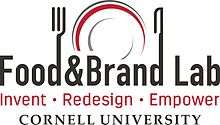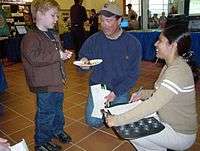Food and Brand Lab

The Food and Brand Lab is a non-profit research facility at Cornell University which focuses on why people buy and eat the foods they do in the quantities they do. The stated mission of the Lab is to "Conduct top level academic research that enables consumers to use food to help them 'to be what they want to be' -- this could involve eating less, eating better, or enjoying food more." By focusing on behavioral and psychological explanations as to why people overeat and why they have the food preferences they have, the Lab aims at helping individuals and health care providers change food-related behaviors and improve health. The Lab is the main force behind the Small Plate Movement, which is encouraging consumers to use smaller dinner plates in their homes and is encouraging restaurants to use smaller plates in their restaurants.
The findings of the lab are widely published in medical, marketing, nutrition, and psychology journals. They have also been summarized in the best-selling book Mindless Eating: Why We Eat More Than We Think (2006) and in Marketing Nutrition (2005), and they have been widely reported in the popular press.
History
The Food and Brand Lab—originally known as the "Brand Lab"—was first established by Brian Wansink while he was a marketing professor at Dartmouth College (1990-1994) and focused on individual food choices. The Lab was then transferred to the Wharton School at the University of Pennsylvania (1995-1997), where its findings began to be noticed by major media outlets. The Wall Street Journal helped raise the Lab's profile when it reported the findings of a series of studies on how package size influences how much food people consume on its front page. The finding that large packages can lead consumers to eat an average of 23% more food than an unconstrained smaller package provided systematic empirical evidence as to how one's immediate environment can bias them to unknowingly overeating.[1] As the first major article on how an implied portion size influences intake and calorie consumption, it helped launch the introduction of mini-size packaging, including the popular, premium-priced 100-calorie packs.[2]
As the Lab began focusing more and more on consumer welfare and nutrition, Wansink moved the Lab to the University of Illinois at Urbana-Champaign, where he was hired as a joint professor of Nutritional Science, Marketing, and Agricultural and Consumer Science. At this time, the newly christened Food and Brand Lab was formally institutionalized, and it broadened its focus to study the environmental factors that unknowingly influenced what a person eats and how much they eat.
To better investigate the interdisciplinary nature of food intake, the Lab recruited researchers from psychology, food science, marketing, agricultural economics, and nutrition, and it broadened its international appeal by incorporating researchers from France, Germany, Korea, India and the Netherlands. At the same time, the Lab has been involved with a licensed research restaurant (the Spice Box), and enlisted the cooperation of grocery store chains to serve as test sites to study a wide range of grocery shopping behaviors.
In 2005, Wansink moved to Cornell University, and the Lab was newly constructed in the Department of Applied Economics and Management in the College of Agriculture and Life Sciences. The new Food and Brand Lab is composed of a multipurpose set of interlocking rooms equipped with one-way mirrors, hidden cameras, and hidden food scales built into tables. The Lab's main research room can be altered to imitate a kitchen or dining room, and in this context, researchers can vary the factors they believe influence food intake and selection in a more naturalistic setting.

In cooperation with the Consumer Education Foundation, the Food and Brand lab sponsors Consumer Camp on the campus of Cornell University on one of the first two weekends in April. This provides a full-day "hands-on" opportunity for people of all ages to learn how to improve what they eat, how much they eat, and how much they enjoy food.
Findings
Research from the Food and Brand Lab has been credited with improving the deeper scientific understanding of food as well as the discovery of some simple everyday insights:
- A person will eat an average of 92% of any food they serve themselves.[3]
- The average person makes over 250 decisions about food each day.[4]
- The Nutritional Gatekeeper of a home influences an estimated 72% of all of the food their family eats.[5]
- Because of visual illusions, people (even bartenders) pour 28% more liquid into a short wide glasses than tall ones.[6]
- 50% of the snack foods bought in bulk are eaten within 6 days.[7]
References
- ↑ "Does Package Size Accelerate Consumption Volume?" (2005) Journal of Marketing, Brian Wansink, 60:3 (January), 1-14.
- ↑ "Seduced By Snacks? No, Not You" by Kim Severson New York Times, 10-11-06, pp. D1+.
- ↑ "Super Bowls: Serving Bowl Size and Food Consumption," (2005) JAMA – Journal of the American Medical Association, Brian Wansink and Matthew M. Cheney, 293:14 (April 13), 1727–1728.
- ↑ "Mindless Eating: The 200 Daily Food Decisions We Overlook," (2007) Environment and Behavior, Brian Wansink and Jeffrey Sobal, 39:1 (January), 106-23.
- ↑ "Nutritional Gatekeepers and the 72% Solution," (2006) Journal of the American Dietetic Association, Brian Wansink 106:9 (September), 1324–1327
- ↑ "Shape of Glass and Amount of Alcohol Poured: Comparative Study of Effect of Practice and Concentration," (2005) BMJ – British Medical Journal, Brian Wansink and Koert van Ittersum, 331:7531 (December 24) 1512–1514.
- ↑ "When are Stockpiled Products Consumed Faster? A Convenience-Salience Framework of Post-purchase Consumption Incidence and Quantity," (2002) Journal of Marketing Research, Pierre Chandon and Brian Wansink, 39:3 (August), 321–335.
Bibliography
- "The Wizard of Why" by Robin Jenkins Mather Chicago Tribune, 3-30-05, Section 7, pp 1+
- "Seduced By Snacks? No, Not You" by Kim Severson New York Times, 10-11-06, pp. D1+.
- "Just Put Your Mind to It" by Nanci Hellmich USA Today, 10-11-06, p. 5D.
- "New Tricks for Eating Better and Less..." Fitness, 11-06, pp. 16–18.
- "I Can’t Believe I Ate the Whole Thing" by Patricia Volk, O Magazine, 11-06, pp. 229–233.